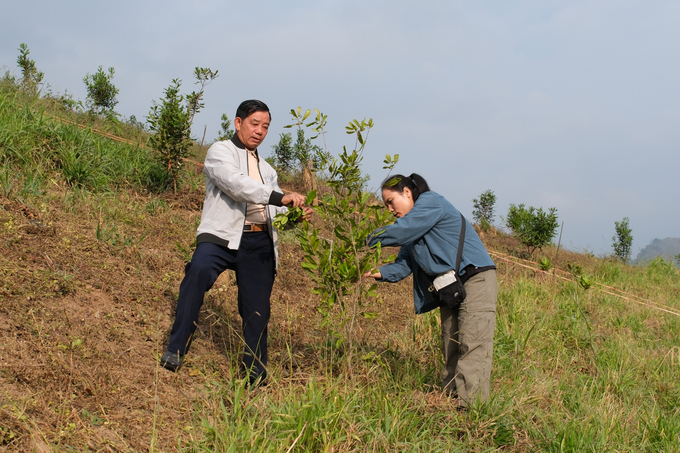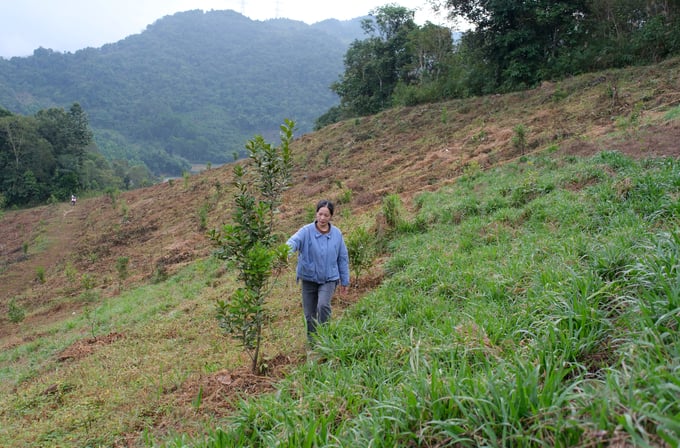November 23, 2025 | 09:24 GMT +7
November 23, 2025 | 09:24 GMT +7
Hotline: 0913.378.918
November 23, 2025 | 09:24 GMT +7
Hotline: 0913.378.918

Mr. Quang Van Thuy, Chairman of the Farmers’ Association of Quai Nua Commune (left) and ASSET project staff (right) visit a sustainable macadamia farming model in Tuan Giao District, Dien Bien Province. Photo: Quynh Chi.
The words of Mr. Quang Van Thuy, Chairman of the Farmers' Association of Quai Nua Commune (Tuan Giao District, Dien Bien Province), carry the weight of a lifetime dedicated to agriculture and local economic development. Quai Nua is a poor commune where most households rely on farming and livestock for their livelihood.
Reflecting on the 1980s, Mr. Thuy recalled the period when the Vietnamese Government allocated farmland to households, encouraging a shift from subsistence farming to commercial agriculture. This marked a turning point, enabling Dien Bien farmers to access new crop varieties such as rice and corn, gradually improving their economic conditions.
However, as cultivated land expanded, environmental challenges grew increasingly severe. Most notably was the depletion of water resources due to deforestation. “Forest resources have been almost completely lost. At this point, upland areas have been exhausted, leaving no room for further expansion,” Mr. Thuy shared.
Following the province’s crop restructuring strategy under the macadamia sustainable development project (2021–2030), Tuan Giao district aims to become Dien Bien’s primary macadamia cultivation hub. In 2023, the district planted 1,700 hectares of new macadamia trees. By 2024, it plans to expand the plantation by an additional 3,300 hectares, bringing the province’s total macadamia-growing area to over 6,000 hectares.
Although the rapid development of macadamia growing areas is a positive sign, showing the economic value of this crop, it requires further solutions for sustaining on sloping land. Quai Nua people are determined to escape poverty and pursue sustainable macadamia cultivation.
In recent years, agroforestry models have brought a fresh perspective to agricultural production in Quai Nua commune and other areas of Dien Bien province. These initiatives are implemented under the “Agroecology and Safe Food System Transitions in Southeast Asia” project (ASSET project).
According to expert Do Trong Hieu, Deputy Director of the Northern Agriculture and Forestry Research and Development Center (under the Northern Mountainous Agriculture and Forestry Science Institute - NOMAFSI), Tuan Giao is a mountainous district where most agricultural land consists of sloping terrain. This topography poses significant challenges for farming, livestock production, and overall economic development.

Experiment with 8 formulas to evaluate multi-purpose cover crops to determine suitable intercropping plants for macadamia trees. Photo: Do Trong Hieu.
Macadamia trees have been identified as a promising crop for economic growth in Tuan Giao. However, due to their wide planting distances, typically 6–7 meters between trees and rows, erosion and leaching occur extensively during the early growth stage when the canopy has yet to close. The low ground coverage also leads to issues such as weed invasion and inefficient land use.
To address these challenges, intercropping macadamia with fodder crops during the canopy development phase presents a valuable opportunity. These intercropped plants not only supplement livestock feed but also enhance soil coverage, reduce erosion, and improve soil protection.
Building on this concept, under the ASSET project, NOMAFSI and CIRAD (the French Agricultural Research Center for International Development) have implemented integrated crop-livestock solutions, considering the sloping land as a productive resource.
Experiments were conducted in Quai Nua commune, Tuan Giao district, using eight different intercropping models to assess the effectiveness of various multipurpose cover crops. These included ruzi grass, Mulato II grass, dice, and soil-improving legumes such as butterfly pea, stylo bean, small bean, and wild peanut. The goal is to identify suitable intercrops for macadamia that can improve soil health, prevent erosion, and provide nutritious forage for livestock.
The farm where the experiment on grass planting to protect and improve soil resources is taking place belongs to Ms. Lo Thi Thuy. She believes that soil health protection involves several crucial factors, from water sources and fertilizers to high-yield crop varieties that are resilient to climate change.
Ms. Thuy observed that in the areas where the pilot model, involving soil-improving plants, was applied, there was a noticeable improvement in soil quality. Particularly, the macadamia trees planted in areas intercropped with dice grew significantly better than those in other plots.

Macadamia trees intercropped with dice grow much better than other trees. Photo: Quynh Chi.
She emphasized: “The plots where we plant trees as part of the project show excellent soil health. Healthy soil means healthy trees. I hope more households will participate in similar models.”
In June 2024, the ASSET project collaborated with the Institute of Soil and Fertilizers to assess soil health in the areas where the model was applied. Ms. Dong Thi Na, ASSET project coordinator in Dien Bien province, shared that although official results are not yet available, feedback from local residents indicates a significant improvement in soil health thanks to the use of legumes.
“Stylo beans, pea pods, and wild peanuts all have nitrogen-fixing abilities, which enrich the soil. When intercropped with macadamia, the trees also grow very well,” said Ms. Na.
The early success of the model has not only motivated Quai Nua commune but also inspired neighboring areas. With its clear economic and environmental benefits, the agroforestry model is expected to be a sustainable solution for efficiently utilizing land resources, enhancing food security, and adapting to climate change.
Mr. Quang Van Thuy, Chairman of the Farmers' Association of Quai Nua Commune, assessed that the ecological agricultural model is well-suited to the local natural conditions. He noted strong community support and a keen interest in accessing the project’s technology.
The Agroecology and Safe Food System Transitions in Southeast Asia (ASSET) project is funded by the French Development Agency (AFD), the European Union (EU), and the French Global Environment Facility (FFEM). The project is being implemented in Cambodia, Laos, Myanmar, and Vietnam, with a partnership of 23 national and international agencies and organizations, including two United Nations organizations.
Translated by Quynh Chi

(VAN) Results from the Sustainable Durian Model Project in Dak Lak have confirmed the critical role of Yara Viet Nam in transferring advanced nutritional solutions to farmers.

(VAN) In Tuyen Quang province, livestock farmers have introduced effective models and innovative practices that significantly strengthen African Swine Fever prevention and control efforts.

(VAN) This is the study conducted by IRRI and Can Tho University on the rice straw value chain in Mekong Delta showing an economic potential of more than 6.6 trillion VND/year.

(VAN) By participating in cooperative economics, many farmers in Tay Ninh have overcome hardship, mastered clean dragon fruit cultivation techniques.

(VAN) The crossbreeding program in the former Binh Dinh province (now part of Gia Lai) has shown signs of decline, and urgent measures are needed to revive it and sustain past achievements.

(VAN) The agricultural sector agreed on a roadmap to pilot the MRV protocol and expand low-emission rice production from the 2025-2026 winter-spring crop.

(VAN) Agricultural extension officers in Quang Ninh do more than transmit knowledge; they have become a steadfast support system for farmers on the path to sustainable agricultural development.